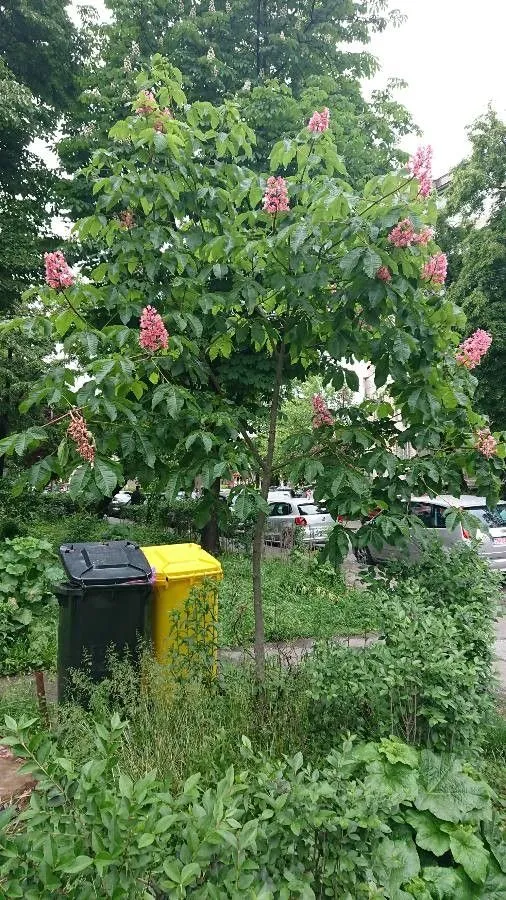
Author: L.
Bibliography: Sp. Pl.: 344 (1753)
Year: 1753
Status: accepted
Rank: species
Genus: Aesculus
Vegetable: False
Observations: C. & SE. U.S.A
Red buckeye (Aesculus pavia) is a small deciduous shrub or tree that is native to the southeastern and central United States. Introduced by the renowned botanist Carl Linnaeus in his seminal work “Species Plantarum” published in 1753, the red buckeye belongs to the Sapindaceae family, which includes a diverse array of flowering plants.
This elegant plant typically reaches heights ranging from 10 to 20 feet, with a similar spread, making it an attractive choice for gardens and open landscapes. The red buckeye is particularly renowned for its stunning floral display. In spring, it produces an abundance of tubular, red to scarlet flowers arranged in upright clusters that can be as long as 6 inches. These striking blooms are not only visually appealing but also serve as a valuable nectar source for hummingbirds and butterflies, aiding in pollination.
The foliage of the red buckeye further adds to its ornamental value. The leaves are palmately compound, usually consisting of five leaflets that emerge a rich green color, creating a dense canopy. As cooler temperatures arrive in the fall, the leaves transition to attractive shades of yellow, enhancing the plant’s seasonal interest.
The red buckeye prefers moist, well-drained soils and can thrive in partial to full shade, making it versatile for various garden settings. It is a great understory plant and can be used effectively in woodland gardens or naturalized areas. Despite its beauty, it is important to note that all parts of the red buckeye plant are toxic if ingested, so caution should be exercised, especially in areas accessible to pets and small children.
Cultivating red buckeye can contribute to ecological balance by attracting and supporting local wildlife. Its hardy nature and attractive features make it a worthy addition to the collection of any plant enthusiast, particularly those interested in native and wildlife-friendly gardening.
Fra: marronnier rouge, marronnier à fleurs rouges, pavier, pavier rouge, marronnier de virginie
Eng: red buckeye, red horsechestnut
Deu: rote rosskastanie, echte pavie
Swe: amerikansk hästkastanj
En: Red buckeye, Red horsechestnut, Damask Horsechestnut, Florida Buckeye
Bg: Червен американски конски кестен
Cs: Jírovec pávie
Nl: Rode Pavia
Fi: Hurmehevoskastanja
Fr: Pavier rouge, Marronnier rouge, Marronnier à fleurs rouges, Pavier, Marronnier de Virginie
De: Echte Pavie, Rote Rosskastanie, Rote Pavie
Hu: Vörös vadgesztenye
Pl: Kasztanowiec krwisty
Ru: Конский каштан красный
Sv: Amerikansk hästkastanj
Uk: Гіркокаштан червоний
Taken May 19, 2022 by Mary Kingfishers (cc-by-sa)
Taken May 18, 2022 by Irmgard Groß (cc-by-sa)
Taken May 5, 2021 by jjcsalmeron (cc-by-sa)
Taken May 19, 2019 by gemmamarie253 gemmamarie253 (cc-by-sa)
Taken Apr 2, 2022 by Alex W (cc-by-sa)
Taken Aug 10, 2021 by Jordan Russell (cc-by-sa)
Taken Apr 27, 2019 by J W (cc-by-sa)
Taken May 19, 2022 by William Coville (cc-by-sa)
Taken Aug 22, 2022 by John Sycorax (cc-by-sa)
Taken May 6, 2019 by Sorin Trinca (cc-by-sa)
Taken Jun 3, 2019 by Jean-Dominique Bellier (cc-by-sa)
Taken May 6, 2019 by Sorin Trinca (cc-by-sa)
Taken Apr 29, 2020 by ste6otto (cc-by-sa)
Taken May 18, 2022 by Irmgard Groß (cc-by-sa)
Taken May 18, 2022 by Irmgard Groß (cc-by-sa)
Taken Sep 27, 2022 by Maria S. (cc-by-sa)
Taken Sep 19, 2022 by Joyce Colon (cc-by-sa)
Taken Oct 6, 2022 by greg whilsmith (cc-by-sa)
Taken Sep 4, 2021 by Sébastien Hustache (cc-by-sa)
Taken Oct 24, 2021 by rickterscale (cc-by-sa)
Taken Aug 5, 2022 by Lau (cc-by-sa)
Taken Apr 21, 2020 by Blob Bloom (cc-by-sa)
Taken May 18, 2022 by Irmgard Groß (cc-by-sa)
Taken May 6, 2019 by Sorin Trinca (cc-by-sa)
Taken May 18, 2022 by Irmgard Groß (cc-by-sa)
Taken Feb 17, 2022 by Eli Small (cc-by-sa)
Taken Feb 22, 2020 by Brad Kelley (cc-by-sa)
© copyright of the Board of Trustees of the Royal Botanic Gardens, Kew.
© copyright of the Board of Trustees of the Royal Botanic Gardens, Kew.
© copyright of the Board of Trustees of the Royal Botanic Gardens, Kew.
Growth form: Single Stem
Growth habit: Tree, Shrub
Growth rate: Moderate
Ph maximum: 7.0
Ph minimum: 3.7
Light: 8
Atmospheric humidity: 5
Soil nutriments: 5
Family: Myrtaceae Author: (F.Muell.) K.D.Hill & L.A.S.Johnson Bibliography: Telopea 6: 402 (1995) Year: 1995 Status:…
Family: Rubiaceae Author: Pierre ex A.Froehner Bibliography: Notizbl. Bot. Gart. Berlin-Dahlem 1: 237 (1897) Year:…
Family: Sapindaceae Author: Koidz. Bibliography: J. Coll. Sci. Imp. Univ. Tokyo 32(1): 38 (1911) Year:…
Family: Asteraceae Author: A.Gray Bibliography: Pacif. Railr. Rep.: 107 (1857) Year: 1857 Status: accepted Rank:…
Family: Fabaceae Author: Medik. Bibliography: Vorles. Churpfälz. Phys.-Ökon. Ges. 2: 398 (1787) Year: 1787 Status:…
Family: Aspleniaceae Author: (Cav.) Alston Bibliography: Bull. Misc. Inform. Kew 1932: 309 (1932) Year: 1932…